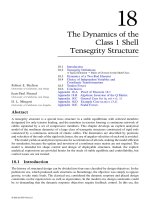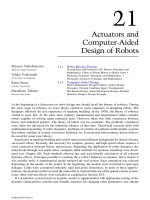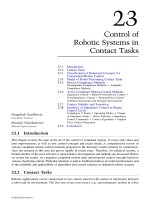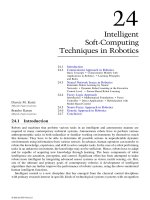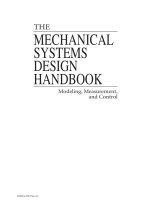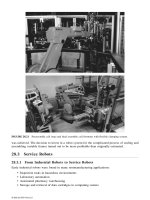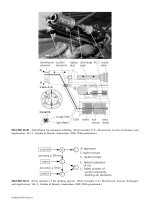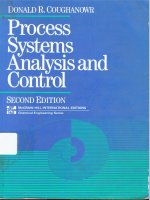process modeling simulation and control for chemical engineers - 2nd ed
Bạn đang xem bản rút gọn của tài liệu. Xem và tải ngay bản đầy đủ của tài liệu tại đây (9.44 MB, 741 trang )
WIlllAM
1.
LUYBENWILLIAM
1.
LUYBEN
I
PROCESS MODELING,PROCESS MODELING,
l
SIMULATION
AND
SIMULATION
AND
\
CONTROL
iOR
5
CONTROL
FlitI
m
CHEMICAL ENGINEERS
m
SECOND
EDITION-
I
a
I
1
L
McGraw-Hill Chemical Engineering Series
’
Editorial Advisory Board
James
J. Carberry,
Profissor of Chemical Engineering, University of Notre Dame
James R. Fair,
Professor of Chemical Engineering, University of Texas, Austin
WilUum
P. Schowalter,
Professor of Chemical Engineering, Princeton University
Matthew
Tirrell,
Professor of Chemical Engineering, University of Minnesota
James
Wei,
Professor of Chemical Engineering, Massachusetts Institute of Technology
Max S. Petem, Emeritus, Professor of Chentical Engineering, University
of
Colorado
Building the Literature of a Profession
Fifteen prominent chemical engineers first met in New York more than 60 years
ago to plan a continuing literature for their rapidly growing profession. From
industry came such pioneer practitioners as Leo H. Baekeland, Arthur D. Little,
Charles L. Reese, John V. N. Dorr, M. C. Whitaker, and R. S. McBride. From
the universities came such eminent educators as William H. Walker, Alfred H.
White, D. D. Jackson, J. H. James, Warren K. Lewis, and Harry A. Curtis. H. C.
Parmelee, then editor of Chemical and Metallurgical Engineering, served as chair-
man and was joined subsequently by S. D. Kirkpatrick as consulting editor.
After several meetings, this committee submitted its report to the McGraw-
Hill Book Company in September 1925. In the report were detailed specifications
for a correlated series of more than a dozen texts and reference books which have
since become the McGraw-Hill Series in Chemical Engineering and which
became the cornerstone of the chemical engineering curriculum.
From this beginning there has evolved a series of texts surpassing by far the
scope and longevity envisioned by the founding Editorial Board. The
McGraw-
Hill Series in Chemical Engineering stands as a unique historical record of the
development of chemical engineering education and practice. In the series one
finds the milestones of the subject’s evolution: industrial chemistry,
stoichio-
metry,
unit operations and processes, thermodynamics, kinetics, and transfer
operations.
Chemical engineering is a dynamic profession, and its literature continues
to evolve. McGraw-Hill and its consulting editors remain committed to a pub-
lishing policy that will serve, and indeed lead, the needs of the chemical engineer-
ing profession during the years to come.
The Series
Bailey and OUii: Biochemical Engineering Fundamentals
Bennett and Myers: Momentum, Heat, amd Mass Transfer
Beveridge and Schechter: Optimization: Theory and Practice
Brodkey and Hershey: Transport Phenomena: A Unified Approach
Carberry: Chemical and Catalytic Reaction Engineering
Constantinides: Applied Numerical Methods with Personal Computers
Cougbanowr and Koppel: Process Systems Analysis and Control
Douglas: Conceptual Design ofchemical Processes
Edgar and Himmelblau: Optimization
ofchemical
Processes
Fabien: Fundamentals of Transport Phenomena
Finlayson: Nonlinear Analysis in Chemical Engineering
Gates, Katzer, and Scbuit: Chemistry of Catalytic Processes
Holland: Fundamentals of Multicomponent Distillation
Holland and Liapis: Computer Methods for Solving Dynamic Separation Problems
Katz, Cornell, Kobayaski, Poettmann, Vary, Elenbaas, aad Weinaug: Handbook of
Natural Gas Engineering
King: Separation Processes
Luyben: Process Modeling, Simulation, and Control for Chemical Engineers
McCabe, Smitb, J. C., and Harriott: Unit Operations of Chemical Engineering
Mickley, Sberwood, and Reed: Applied Mathematics in Chemical Engineering
Nelson: Petroleum Refinery Engineering
Perry and Cbilton (Editors): Chemical Engineers’ Handbook
Peters: Elementary Chemical Engineering
Peters and Timmerbaus: Plant Design and Economics for Chemical Engineers
Probstein and Hicks: Synthetic Fuels
Reid, Prausnitz, and Sherwood: The Properties of Gases and Liquids
Resnick: Process Analysis and Design for Chemical Engineers
Satterfield: Heterogeneous Catalysis in Practice
Sberwood,
Pigford,
aad Wilke: Mass Transfer
Smith, B. D.: Design of Equilibrium Stage Processes
Smith, J. M.: Chemical Engineering Kinetics
Smith, J. M., and Van Ness: Zntroduction to Chemical Engineering Thermodynamics
Treybal: Mass Transfer Operations
VaUe-Riestra: Project Evolution in the Chemical Process Industries
Van Ness and Abbott: Classical Thermodynamics of Nonelectrolyte Solutions:
with Applications to Phase Equilibria
Van Winkle: Distillation
Volk: Applied Statistics for Engineers
-/
Walas: Reaction Kinetics for Chemical Engineers
.J
J
Wei, Russell, and Swartzlander: The Structure of the Chemical Processing Industries
WbitweU and Toner: Conservation of Mass and E
-’
.
/
/
Also available from McGraw-Hill
Schaum’s Outline Series in Civil Engineering
Each outline includes basic theory, definitions, and hundreds of solved
problems and supplementary problems with answers.
Current List Includes:
Advanced Structural Analysis
Basic Equations of Engineering
Descriptive Geometry
Dynamic Structural Analysis
Engineering
Mechanics, 4th edition
Fluid Dynamics
Fluid
Mechanics
& Hydraulics
Introduction to Engineering Calculations
Introductory Surveying
Reinforced Concrete Design, 2d edition
Space Structural Analysis
Statics and Strength of Materials
Strength of Materials, 2d edition
Structural Analysis
Theoretical Mechanics
.
-
Available at Your College Bookstore
PROCESS MODELING,
SIMULATION, AND
CONTROL FOR
CHEMICAL ENGINEERS
Second Edition
William L. Luyben
Process Modeling and Control Center
Department of Chemical Engineering
Lehigh University
McGraw-Hill
Publisbing
Company
New
York St. Louis San Francisco Auckland Bogota Caracas Hamburg
Lisbon London Madrid Mexico Milan Montreal New Delhi
Oklahoma City Paris San Juan
SHo
Paul0
Singapore Sydney Tokyo Toronto
PROCESS MODELING, SIMULATION, AND CONTROL FOR
CHEMICAL ENGINEERS
INTERNATIONAL EDITION 1996
Exclusive rights by McGraw-Hill Book
Co
Singapore for
manufacture and export. This book cannot be m-exported
from the country to which it is consigned by McGraw-Hill.
567690BJEPMP9432
Copyright e 1999, 1973 by McGraw-Hill, Inc.
All rights reserved. Except as permitted under the United States Copyright
Act of 1976, no part of this publication may be reproduced or distributed in
any form or by any means, or stored in a data base or retrieval system,
u
without the prior written permission of the publisher.
This book was set in Times Roman.
The editors were Lyn Beamesderfer and John M.
Morris.%
The production supervisor was Friederich W. Schulte.
The cover was designed by John Hite.
Project supervision was done by Harley Editorial Services.
Ubrury of Congress Cataloging-in-Publlcatlon Data
William L. Luyben 2nd ed.
p.
cm.
Bibliography: p.
Includes index.
ISBN
6-67-639159-9
1. Chemical process-Math
data processing., 3. Chemica
TP155.7.L66
1969 ,
669.2’61-dc19
When ordering this title use ISBN
1
process
No.DEADQUiSICION
ABOUT THE AUTHOR
William L. Luyben received his B.S. in Chemical Engineering from the Penn-
sylvania State University where he was the valedictorian of the Class of 1955. He
worked for Exxon for five years at the
Bayway
Refinery and at the Abadan
Refinery (Iran) in plant. technical service and design of petroleum processing
units. After earning a Ph.D. in 1963 at the University of Delaware, Dr. Luyben
worked for the Engineering Department of DuPont in process dynamics and
control of chemical plants. In 1967 he joined Lehigh University where he is now
Professor of Chemical Engineering and Co-Director of the Process Modeling and
Control Center.
Professor Luyben has published over 100 technical papers and has
authored or coauthored four books. Professor Luyben has directed the theses of
over 30 graduate students. He is an active consultant for industry in the area of
process control and has an international reputation in the field of distillation
column control. He was the recipient of the
Beckman
Education Award in 1975
and the
Instrumqntation
Technology Award in 1969 from the Instrument Society
of America.
f
r ,
.,y<i
‘.,
Overall,
he
has devoted
ove$?
3$,years to, his profession as a teacher,
researcher, author, and practicing en&eer:
:.:
’
!
1.
I’
vii
This book is dedicated to
Robert L. Pigford and Page S. Buckley,
two authentic pioneers
in process modeling
and process control
CONTENTS
1
1.1
1.2
1.3
1.4
1.5
1.6
Part I
Preface
Introduction
1
Examples of the Role of Process Dynamics
and Control
Historical Background
Perspective
Motivation for Studying Process Control
General Concepts
Laws and Languages of Process Control
1.6.1
Process Control Laws
1.6.2
Languages of Process Control
1
6
7
8
8
11
11
12
Mathematical Models of
Chemical Engineering Systems
Xxi
2
Fundamentals
2.1
Intreduction
2.1.1
Uses of Mathematical Models
2.1.2 Scope of Coverage
2.1.3
Principles of Formulation
2.2
Fundamental Laws
2.2.1 Continuity Equations
2.2.2 Energy Equation
2.2.3
Equations of Motion
2.2.4 Transport Equations
2.2.5
Equations of State
2.2.6 Equilibrium
2.2.7 Chemical Kinetics
Problems
15
15
15
16
16
17
17
23
27
31
32
33
36
38
xi
I
4
Xii CONTENTS
3
3.1
3.2
3.3
3.4
3.5
3.6
3.7
3.8
3.9
3.10
3.11
3.12
3.13
3.14
Part II
Examples of Mathematical Models
of Chemical Engineering Systems
Introduction
Series of Isothermal, Constant-Holdup CSTRs
CSTRs With Variable Holdups
Two Heated Tanks
Gas-Phase, Pressurized CSTR
Nonisothermal CSTR
Single-Component Vaporizer
Multicomponent Flash Drum
Batch Reactor
Reactor With Mass Transfer
Ideal Binary Distillation Column
Multicomponent Nonideal Distillation Column
Batch Distillation With Holdup
pH
Systems
3.14.1 Equilibrium-Constant Models
3.14.2 Titration-Curve Method
Problems
Computer Simulation
40
40
41
43
44
45
46
51
54
57
62
64
70
72
74
74
75
77
4 Numerical Methods
89
4.1
Introduction
89
4.2
Computer Programming
90
4.3
Iterative Convergence Methods
91
4.3.1 Interval Halving
93
4.3.2 Newton-Raphson Method
96
4.3.3 False Position
100
4.3.4
Explicit Convergence Methods
101
4.35 Wegstein
103
4.3.6 Muller Method
103
4.4
Numerical Integration of Ordinary Differential Equations
105
4.4.1
Explicit Numerical Integration Algorithms
106
4.4.2 Implicit Methods
113
Problems
114
5
Simulation Examples
5.1
Gravity-Flow Tank
5.2
Three CSTRs in Series
5.3
Nonisothermal CSTR
5.4
Binary Distillation Column
5.5
Multicomponent Distillation Column
5.6 Variable Pressure Distillation
5.6.1
Approximate Variable-Pressure Model
5.6.2
Rigorous Variable-Pressure Model
116
116
119
124
129
132
141
141
142
.
.
.
CONTENTS
xlu
5.7 Batch Reactor
150
5.8
Ternary Batch Distillation With Holdup
157
Problems
162
Part III Time-Domain Dynamics and Control
6 Time-Domain Dynamics
6.1
Classification and Dethtition
6.2
Linearization and Perturbation Variables
6.2.1 Linearization
6.2.2 Perturbation Variables
6.3
Responses of Simple Linear Systems
6.3.1
First-Order Linear Ordinary Differential Equation
6.3.2
Second-Order Linear
ODES
With Constant Coefficients
6.3.3
Nth-Order Linear
ODES
With Constant Coefficients
6.4 Steadystate Techniques
Problems
7
Corkentional Control Systems and Hardware
205
7.1
Control Instrumentation
205
7.1.1 Sensors
207
7.1.2 Transmitters
211
7.1.3 Control Valves
213
7.1.4
Analog and Digital Controllers
222
7.1.5
Computing and Logic Devices
226
7.2
Performance of Feedback Controllers
226
7.2.1
Specifications for Closedloop Response
226
7.2.2 Load Performance
227
7.3
Controller Tuning
231
7.3.1
Rules of Thumb
231
7.3.2
On-Line Trial and Error
234
7.3.3 Ziegler-Nichols Method
235
Problems
238
8 Advanced Control Systems
8.1
Ratio Control
8.2
Cascade Control
8.3
Computed Variable Control
8.4
Override Control
8.4.1 Basic System
8.4.2 Reset Windup
8.5
Nonlinear and Adaptive Control
8.5.1 Nonlinear Control
8.5.2 Adaptive Control
8.6
Valve-Position Control
8.7
Feedfonvard Control Concepts
167
167
171
171
175
177
177
182
192
195
198
253
253
255
257
259
259
261
262
262
263
263
265
Xiv CONTENTS
8.8
Control System Design Concepts
268
8.8.1 General Guidelines
268
8.8.2
Trade-Offs Between Steadystate Design and Control
273
8.8.3 Plant-Wide Control
274
8.9
Dynamic Matrix Control
281
8.9.1
Review of Least Squares
281
8.9.2 Step-Response Models
284
8.9.3 DMC Algorithm
287
Problems
288
Part IV Laplace-Domain Dynamics and Control
9
9.1
9.2
9.3
9.4
9.5
9.6
9.7
10
10.1
10.2
Laplace-Domain Dynamics
Laplace-Transformation Fundamentals
9.1.1 Definition
9.1.2 Linearity Property
Laplace Transformation of Important Functions
9.2.1 Step Function
9.2.2 Ramp
9.2.3 Sine
9.2.4 Exponential
9.2.5
Exponential Multiplied By Time
9.2.6
Impulse (Dirac Delta Function
6,,,)
Inversion of Laplace Transforms
Transfer Functions
9.4.1
Multiplication by a Constant
9.4.2
Differentiation With Respect To Time
9.4.3 Integration
9.4.4 Deadtime
Examples
Properties of Transfer Functions
9.6.1 Physical Realizability
9.6.2
Poles and Zeros
9.6.3 Steadystate Gains
Transfer Functions for Feedback Controllers
Problems
Laplace-Domain Analysis of Conventional
Feedback Control Systems
Openloop and Closedloop Systems
10.1.1
Openloop Characteristic Equation
10.1.2
Closedloop Characteristic Equation and Closedloop
Transfer Function
Stability
10.2.1
Routh Stability Criterion
10.2.2
Direct Substitution For Stability Limit
303
303
303
304
304
304
305
306
306
307
307
308
311
312
312
314
315
316
325
325
326
327
329
331
339
340
340
341
345
346
348
CONTENTS
xv
10.3
10.4
Performance Specifications
350
10.3.1 Steadystate Performance
350
10.3.2 Dynamic Specifications
351
Root Locus Analysis
353
10.4.1 Definition
353
10.4.2
Construction of Root Locus Curves
357
10.4.3 Examples
363
Problems
367
11
11.1
11.2
11.3
11.4
11.5
Laplace-Domain Analysis of Advanced
Control Systems
Cascade Control
11.1.1 Series Cascade
11.1.2 Parallel Cascade
Feedforward Control
11.2.1 Fundamentals
11.2.2
Linear Feedforward Control
11.2.3
Nonlinear Feedforward Control
(Ipenloop Unstable Processes
11.3.1.
Simple Systems
11.3.2
Effects of Lags
11.3.3 PD Control
11.3.4
Effects of Reactor Scale-up On Controllability
Processes With Inverse Response
Model-Based Control
11.51
Minimal Prototype Design
11.52
Internal Model Control
Problems
Part V
Frequency-Domain Dynamics and Control
376
376
377
382
383
383
384
389
391
392
397
397
398
398
402
402
404
407
12
Frequency-Domain Dynamics
12.1
Definition
12.2
Basic Theorem
12.3
Representation
12.3.1 Nyquist Plots
12.3.2 Bode Plots
12.3.3 Nichols Plots
12.4
Frequency-Domain Solution Techniques
Problems
415
415
417
420
421
427
440
442
452
13
Frequency-Domain
Analysis
ofClosedloop Systems
455
13.1
Nyquist Stability Criterion
456
13.1.1 Proof
456
13.1.2 Examples
460
13.1.3 Representation
468
.
xvi
coNTENls
13.2
13.3
ii4
Closedloop Specifications in the Frequency Domain
470
13.2.1 Phase Margin
470
\’
13.2.2 Gain Margin
470
13.2.3
Maximum Closedloop Log Modulus
(Ly)
472
Frequency Response of Feedback Controllers
478
13.3.1
Proportional Controller (P)
478
13.3.2
Proportional-Integral Controller (PI)
479
13.3.3
Proportional-Integral-Derivative Controller (PID)
481
Examples
481
13.4.1 Three-CSTR System
481
13.4.2
First-Order Lag With Deadtime
488
13.4.3
Openloop Unstable Processes
490
Problems
493
14
14.1
14.2
14.3
14.4
14.5
14.6
14.7
14.8
Process Identification
502
Purpose
502
Direct Methods
503
14.2.1
Time-Domain
(L
Eyeball
”
Fitting of Step Test Data
503
14.2.2
Direct Sine-Wave Testing
505
Pulse Testing
507
14.3.1
Calculation of Gu,, From Pulse Test Data
508
14.3.2
Digital Evaluation of Fourier Transformations
512
14.3.3
Practical Tips on Pulse Testing
515
14.3.4
Processes With Integration
516
Step Testing
518
ATV
Identification
519
14.51
Autotuning
520
14.52
Approximate Transfer Functions
522
Least-Squares Method
525
State Estimators
529
Relationships Among Time, Laplace, and Frequency Domains
530
14.8.1
Laplace to Frequency Domain
530
14.8.2
Frequency to Laplace Domain
530
14.8.3
Time to Laplace Domain
530
14.8.4
Laplace to Time Domain
530
14.85
Time to Frequency Domain
532
14.8.6
Frequency to Time Domain
532
Problems
533
Part VI Multivariable Processes
15
Matrix Properties and State
Variables
537
15.1
Matrix Mathematics
537
15.1.1 Matrix Addition
538
15.1.2 Matrix Multiplication
538
comwrs
xvii
151.3
Transpose of a Matrix
539
151.4
Matrix Inversion
540
15.2
Matrix Properties
541
15.2.1
Eigenvalues
542
15.212
Canonical Transformation
543
152.3
Singular Values
546
15.3
Representation of Multivariable Processes
548
15.3.1
Transfer Function Matrix
548
15.3.2
State Variables
551
15.4
Openloop and Closedloop Systems
554
15.4.1
Transfer Function Representation
554
15.4.2
State Variable Representation
556
15.5
Computer Programs For Matrix Calculations
559
Problems
561
16
Analysis of Multivariable Systems
16.1
Stability
16.1.1
Openloop and Closedloop Characteristic Equations
16.1.2
Multivariable Nyquist Plot
16.1.3 Characteristic Loci Plots
16.1.4
Niederlinski Index
*
16.2
Resiliency
16.3
Interaction
16.3.1
Relative Gain Array (Bristol Array)
16.3.2
Inverse Nyquist Array
(INA)
16.3.3 Decoupling
16.4
Robustness
16.4.1
Trade-off Between Performance and Robustness
16.4.2 Doyle-Stein Criterion
16.4.3 Skogestad-Morari Method
Problems
17
Design of Controllers For Multivariable Processes
17.1
17.2
17.3
17.4
17.5
17.6
17.7
Problem Definition
Selection of Controlled Variables
17.2.1 Engineering Judgment
17.2.2
Singular Value Decomposition
Selection of Manipulated Variables
Elimination of Poor Pairings
BLT Tuning
Load Rejection Performance
Multivariable Controllers
17.7.1 Multivariable DMC
17.7.2 Multivariable IMC
Problems
562
562
562
564
568
572
573
575
576
579
581
584
585
585
588
591
594
594
596
596
596
598
598
599
605
606
606
609
611
.
.
.
XVIII CONTENTS
Part VII Sampled-Data Control Systems
18
Sampling and
z
Transforms
18.1
18.2
18.3
18.4
18.5
18.6
18.7
18.8
18.9
Introduction
18.1.1 Definition
18.1.2
Occurrence of Sampled-Data Systems in
Chemical Engineering
Impulse Sampler
Basic Sampling Theorem
z
Transformation
18.4.1 Definition
18.4.2
Derivation of z Transforms of Common Functions
18.4.3
Effect of Deadtime
18.4.4 z-Transform Theorems
18.4.5 Inversion
Pulse Transfer Functions
Hold Devices
Openloop and Closedloop Systems
18.7.1 Openloop Systems
18.7.2 Closedloop Systems
Discrete Approximation of Continuous Transfer Functions
Modified z Transforms
18.9.1 Definition
18.9.2
Modified z Transforms of Common Functions
Problems
19
19.1
19.2
Stability Analysis of Sampled-Data Systems
19.3
19.4
Stability in the z Plane
Root Locus Design Methods
19.2.1
z-Plane Root Locus Plots
19.2.2
Log-z Plane Root Locus Plots
Bilinear Transformation
Frequency-Domain Design Techniques
19.4.1
Nyquist Stability Criterion
19.4.2 Rigorous Method
19.4.3 Approximate Method
Problems
20
20.1
20.2
20.3
Design of Digital Compensators
Physical Realizability
Frequency-Domain Effects
Minimal-Prototype Design
203.1 Basic Concept
20.3.2
Other Input Types
20.3.3 Load Inputs
20.3.4 Second-Order Processes
20.3.5
Shunta Dual Algorithm
20.3.6 Dahlin Algorithm
615
615
615
615
620
623
626
626
626
629
630
631
636
638
639
639
643
648
651
651
652
655
657
657
660
660
669
672
675
675
676
681
682
685
686
687
689
689
692
694
696
699
701
CONTENTS
Xix
20.4
Sampled-Data Control of Processes With Deadtime
702
20.5
Sampled-Data Control of Openloop Unstable Processes
705
Problems
709
Appendix
Instrumentation Hardware
711
Index
721
.
PREFACE
The first edition of this book appeared over fifteen years ago. It was the first
chemical engineering textbook to combine modeling, simulation, and control. It
also was the first chemical engineering book to present sampled-data control.
This choice of subjects proved to be popular with both students and teachers and
of considerable practical utility.
During the ten-year period following publication, I resisted suggestions
from the publisher to produce a second edition because I felt there were really
very few useful new developments in the field. The control hardware had changed
drastically, but the basic concepts and strategies of process control had under-
gone little change. Most of the new books that have appeared during the last
fifteen
years are very similar in their scope and content to the first edition. Basic
classical control is still the major subject.
However, in the last five years, a number of new and useful techniques have
been developed. This is particularly true in the area of multivariable control.
Therefore I feel it is time for a second edition.
In the area of process control, new methods of analysis and synthesis of
control systems have been developed and need to be added to the process control
engineer’s bag of practical methods. The driving force for much of this develop-
ment was the drastic increase in energy costs in the 1970s. This led to major
redesigns of many new and old processes, using energy integration and more
complex processing schemes. The resulting plants are more interconnected. This
increases control loop interactions and expands the dimension of control prob-
lems. There are many important processes in which three, four, or even more
control loops interact.
As a result, there has been a lot of research activity in multivariable control,
both in academia and in industry. Some practical, useful tools have been devel-
oped to design control systems for these multivariable processes. The second
edition includes a fairly comprehensive discussion of what I feel are the useful
techniques for controlling multivariable processes.
xxi
.
Xxii
PREFACE
Another significant change over the last decade has been the dramatic
increase in the computational power readily available to engineers. Most calcu-
lations can be performed on personal computers that have computational horse-
power equal to that provided only by mainframes a few years ago. This means
that engineers can now routinely use more rigorous methods of analysis and
synthesis. The second edition includes more computer programs. All are suitable
for execution on a personal computer.
In the area of mathematical modeling, there has been only minor progress.
We still are able to describe the dynamics of most systems adequately for engi-
neering purposes. The trade-off between model rigor and computational effort
has shifted toward more precise models due to the increase in computational
power noted above. The second edition includes several more examples of models
that are more rigorous.
In the area of simulation, the analog computer has almost completely dis-
appeared. Therefore, analog simulation has been deleted from this edition. Many
new digital integration algorithms have been developed, particularly for handling
large numbers of “stiff” ordinary differential equations. Computer programming
is now routinely taught at the high school level. The-second edition includes an
expanded treatment of iterative convergence methods
and-
of numerical integra-
tion algorithms for ordinary differential equations, including both explicit and
implicit methods.
The second edition presents some of the material in a slightly different
sequence. Fifteen additional years of teaching experience have convinced me that
it is easier for the students to understand the time,
Laplace,
and frequency tech-
niques if both the dynamics and the control are presented together for each
domain. Therefore, openloop dynamics and closedloop control are both dis-
cussed in the time domain, then in the
Laplace
domain, and finally in the fre-
quency domain. The
z
domain is discussed in Part VII.
There has been a modest increase in the number of examples presented in
the book. The number of problems has been greatly increased. Fifteen years of
quizzes have yielded almost 100 new problems.
The new material presented in the second edition has come from many
sources. I would like to express my thanks for the many useful comments and
suggestions provided by colleagues who reviewed this text during the course of its
development, especially to Daniel H. Chen, Lamar University; T. S. Jiang, Uni-
versity of Illinois-Chicago; Richard Kerrnode, University of Kentucky; Steve
Melsheimer, Cignson University; James Peterson, Washington State University;
and R. Russell Rhinehart, Texas Tech University. Many stimulating and useful
discussions of multivariable control with Bjorn Tyreus of DuPont and Christos
Georgakis of Lehigh University have contributed significantly. The efforts and
suggestions of many students are gratefully acknowledged. The
“
LACEY” group
(Luyben, Alatiqi, Chiang, Elaahi, and Yu) developed and evaluated much of
the new material on multivariable control discussed in Part VI. Carol Biuckie
helped in the typing of the final manuscript. Lehigh undergraduate and graduate
classes have contributed to the book for over twenty years by their questions,
.
.
.
PREFACE XXIII
youthful enthusiasm, and genuine interest in the subject. If the ultimate gift that
a teacher can be given is a group of good students, I have indeed been blessed.
Alhamdulillahi!
William L. Luyben
PROCESS MODELING, SIMULATION,
AND CONTROL FOR CHEMICAL ENGINEERS
CHAPTER
1
INTRODUCTION
This chapter is an introduction to process dynamics and control for those stu-
dents who have had little or no contact or experience with real chemical engi-
neering processes. The objective is to illustrate where process control fits into the
picture and to indicate its relative importance in the operation, design, and devel-
opment of a chemical engineering plant.
This introductory chapter is, I am sure, unnecessary for those practicing
engineers who may be using this book. They are well aware of the importance of
considering the dynamics of a process and of the increasingly complex and
sophisticated control systems that are being used. They know that perhaps 80
percent of the time that one is “on the plant” is spent at the control panel,
watching recorders and controllers (or CRTs). The control room is the nerve
center of the plant.
1.1 EXAMPLES OF THE ROLE
OF PROCESS DYNAMICS AND CONTROL
Probably the best way to illustrate what we mean by process dynamics and
control is to take a few real examples. The first example describes a simple
process where dynamic response, the time-dependent behavior, is important. The
second example illustrates the use of a single feedback controller. The third
example discusses a simple but reasonably typical chemical engineering plant and
its conventional control system involving several controllers.
Example 1.1. Figure 1.1 shows a tank into which an incompressible (constant-
density) liquid is pumped at a variable rate F,
(ft3/s).
This inflow rate can vary with
1
2
PROCESS MODELING, SIMULATION. AND CONTROL FOR CHEMICAL ENGINEERS
FIGURE 1.1
Gravity-flow tank.
time because of changes in operations upstream. The height of liquid in the vertical
cylindrical tank is
h
(ft). The flow rate out of the tank is F
(ft’/s).
Now
F,
, h, andf will all vary with time and are therefore functions of time
t.
Consequently we use the notation
Foe,),
I+,),
and
F(,,
. Liquid leaves the base of the
tank via a long horizontal pipe and discharges into the top of another tank. Both
tanks are open to the atmosphere.
Let us look first at the steadystate conditions. By steadystate we mean, in
most systems, the conditions when nothing is changing with time. Mathematically
this corresponds to having all time derivatives equal to zero, or to allowing time to
become very large, i.e., go to infinity. At steadystate the flow rate out of the tank
must equal the flow rate into the tank. In this book we will denote steadystate
values of variables by an overscore or bar above the variables. Therefore at steady-
state in our tank system
Fe
=
F.
For a given
F,
the height of liquid in the tank at steadystate would also be
some constant
Ii.
The value of
h
would be that height that provides enough hydrau-
lic pressure head at the inlet of the pipe to overcome the frictional losses of liquid
flowing down the pipe. The higher the flow rate
F,
the higher
6
will be.
In the steadystate design of the tank, we would naturally size the diameter of
the exit line and the height of the tank so that at the maximum flow rate expected
the tank would not overflow. And as any good, conservative design engineer knows,
we would include in the design a 20 to 30 percent safety factor on the tank height.
Actual height specified
_________
Maximum design height
F
FIGURE 1.2FIGURE 1.2
Steadystate height versus flow.Steadystate height versus flow.
INTRODUmION
3
Since this is a book on control and instrumentation, we might also mention that a
high-level alarm and/or an interlock (a device to shut off the feed if the level gets too
high) should be installed to guarantee that the tank would not spill over. The tragic
accidents at Three Mile Island, Chernobyl, and Bhopal illustrate the need for well-
designed and well-instrumented plants.
The design of the system would involve an economic balance between the cost
of a taller tank and the cost of a bigger pipe, since the bigger the pipe diameter the
lower is the liquid height. Figure 1.2 shows the curve of
!i
versus F for a specific
numerical case.
So far we have considered just the traditional steadystate design aspects of
this fluid flow system. Now let us think about what would happen dynamically if we
changed Fe. How will
he)
and
F$)
vary with time? Obviously F eventually has to
end up at the new value of F,. We can easily determine from the steadystate design
curve of Fig. 1.2 where
h
will go at the new steadystate. But what paths will
h(,,
and
Fgb
take to get to their new steadystates?
Figure 1.3 sketches the problem. The question is which curves (1 or 2) rep-
resent the actual paths that F and
h
will follow. Curves 1 show gradual increases in
h
and F to their new steadystate values. However, the paths could follow curves 2
where the liquid height rises above its final steadystate value. This is called
“overshoot.” Clearly, if the peak of the overshoot in
h
is above the top of the tank,
we would be in trouble.
Our steadystate design calculations tell us nothing about what the dynamic
response to the system will be. They tell us where we will start and where we will
end up but not how we get there. This kind of information is what a study of the
dynamics of the system will reveal. We will return to this system later in the book to
derive a mathematical model of it and to determine its dynamic response quantita-
tively by simulation.
Example 1.2. Consider the heat exchanger sketched in Fig. 1.4. An oil stream passes
through the tube side of a tube-in-shell heat exchanger and is heated by condensing
steam on the shell side. The steam condensate leaves through a steam trap (a device
4
PROCESS MODELING, SIMULATION, AND CONTROL FOR CHEMICAL ENGINEERS
FIGURE 1.4
that only permits liquid to pass through it, thus preventing “blow through” of the
steam vapor). We want to control the temperature of the oil leaving the heat
exchanger. To do this, a thermocouple is inserted in a thermowell in the exit oil
pipe. The thermocouple wires are connected to a “temperature transmitter,” an elec-
tronic device that converts the millivolt thermocouple output into a
4-
to
20-
milliampere “control signal.” The current signal is sent into a temperature
controller, an electronic or digital or pneumatic device that compares the desired
temperature (the “setpoint”) with the actual temperature, and sends out a signal to
a control valve. The temperature controller opens the steam valve more if the tem-
perature is too low or closes it a little if the temperature is too high.
We will consider all the components of this temperature control loop in more
detail later in this book. For now we need’only appreciate the fact that the auto-
matic control of some variable in a process requires the installation of a sensor, a
transmitter, a controller, and a final control element (usually a control valve). Most
of this book is aimed at learning how to decide what type of controller should be
used and how it should be “tuned,” i.e., how should the adjustable tuning param-
eters in the controller be set so that we do a good job of controlling temperature.
Example 1.3. Our third example illustrates a typical control scheme for an entire
simple chemical plant. Figure 1.5 gives a simple schematic sketch of the process
configuration and its control system. Two liquid feeds are pumped into a reactor in
which they react to form products. The reaction is exothermic, and therefore heat
must be removed from the reactor. This is accomplished by adding cooling water to
a jacket surrounding the reactor. Reactor emuent is pumped through a preheater
into a distillation column that splits it into two product streams.
‘Traditional steadystate design procedures would be used to specify the
various pieces of equipment in the plant:
Fluid mechanics. Pump heads, rates, and power; piping sizes; column tray
layout and sizing; heat-exchanger tube and shell side batlling and sizing
Heat transfer. Reactor heat removal; preheater, reboiler, and condenser heat
transfer areas; temperature levels of steam and cooling water
Chemical kinetics. Reactor size and operating conditions (temperature, pres-
sure, catalyst, etc.)
